Prediction of Fatigue Limit of Spring Steel Considering Surface Defect Size and Stress Ratio
Abstract
1. Introduction
2. Equations for Predicting Fatigue Limit
3. Experimental Method
3.1. Material Used
3.2. Surface Hardness and Roughness
3.3. Fatigue Test
3.4. Observations of Fracture Surface
4. Results and Discussion
4.1. Result of Surface Hardness and Roughness
4.2. Fatigue Test Results
4.3. Effect of Stress Ratio on Fatigue Limit and
4.4. Observations of Fracture Surface
5. Prediction of Fatigue Limit
6. Conclusions
- (1)
- As the stress ratio increased from −1 to 0.4, the fatigue limit decreased under all slit conditions due to mean stress. The rate of decrease in the fatigue limit owing to the defects decreased as the stress ratio was increased.
- (2)
- Based on the test results for the smooth specimen and the 400-µm slit specimen, the stress-ratio dependence of the fatigue limit of the smooth specimen, , and the threshold-stress-intensity factor range, , of the investigated spring steel could be determined.
- (3)
- The results of the fatigue tests showed that the fatigue limit decreased as the defect size was increased, irrespective of the stress ratio. In the case of the 30 µm slit specimen, the fatigue limit did not decrease from only at R = 0.4. Thus, we found that the dimensions of the surface defects that did not result in a decrease in the fatigue limit were dependent on the stress ratio.
- (4)
- The modified El-Haddad’s equation, i.e., Equation (8), yielded values close to the experimental data for a wide range of values and stress ratios. Murakami’s equation, that is, Equation (4), yielded values close to the experimental data between and , but above it yielded non-conservative values with respect to the experimental results. Smith’s equation, that is, Equation (6), yielded highly non-conservative values near . Thus, the usefulness of the modified El-Haddad’s equation was clarified for a wide range of defect dimensions and stress ratios.
Author Contributions
Funding
Data Availability Statement
Acknowledgments
Conflicts of Interest
Nomenclature
| stress range (twice stress amplitude) | |
| fatigue limit | |
| fatigue limit of smooth specimen | |
| mean stress | |
| ultimate tensile strength | |
| 0.2% offset yield strength | |
| maximum stress intensity factor | |
| threshold stress intensity factor range for long crack | |
| shape factor | |
| defect size | |
| intrinsic defect size | |
| square root of the area projected in the direction of principal stress | |
| of critical defects which decrease the fatigue limit | |
| of the transition defect between small and large defects | |
| of intrinsic defect | |
| HV | Vickers hardness |
| stress ratio | |
| material constant | |
| a/c | aspect ratio |
| arithmetic mean roughness | |
| maximum height of roughness |
References
- Zhang, Y.; Lai, X.; Zhu, P.; Wang, W. Lightweight design of automobile component using high strength steel based on dent resistance. Mater. Des. 2006, 27, 64–68. [Google Scholar] [CrossRef]
- Tekeli, S. Enhancement of fatigue strength of SAE 9245 steel by shot peening. Mater. Lett. 2002, 57, 604–608. [Google Scholar] [CrossRef]
- Misaka, Y.; Kawasaki, K.; Komotori, J.; Shimizu, M. Fatigue strength of ferritic ductile cast iron hardened by super rapid induction heating and quenching. Mater. Trans. 2004, 45, 2930–2935. [Google Scholar] [CrossRef][Green Version]
- Akita, M.; Tokaji, K. Effect of carburizing on notch fatigue behaviour in AISI 316 austenitic stainless steel. Surf. Coat. Technol. 2006, 200, 6073–6078. [Google Scholar] [CrossRef]
- Sugimoto, K.; Hojo, T.; Mizuno, Y. Torsional fatigue strength of newly developed case hardening TRIP-aided steel. Metals 2017, 7, 375. [Google Scholar] [CrossRef]
- Yamada, Y.; Hirohito, E.; Takahashi, K. Influence of crystal structure of nitride compound layer on torsion fatigue strength of alloy steel. Metals 2019, 9, 1352. [Google Scholar] [CrossRef]
- Gromov, V.E.; Gorbunov, S.V.; Ivanov, Y.F.; Vorobiev, S.V.; Konovalov, S.V. Formation of surface gradient structural-phase states under electron-beam treatment of stainless steel. J. Surf. Investig. 2011, 5, 974–978. [Google Scholar] [CrossRef]
- Murakami, Y.; Yamashita, Y. Prediction of life and scatter of fatigue failure originated at nonmetallic inclusions. Procedia Eng. 2014, 74, 6–11. [Google Scholar] [CrossRef]
- Furuya, Y.; Matsuoka, S.; Abe, T. A novel inclusion inspection method employing 20 kHz fatigue testing. Metall. Mater. Trans. A 2003, 34, 2517–2526. [Google Scholar] [CrossRef]
- Das, S.K.; Mukhopadhyay, N.K.; Kumar, B.R.; Bhattacharya, D.K. Failure analysis of a passenger car coil spring. Eng. Fail. Anal. 2007, 14, 158–163. [Google Scholar] [CrossRef]
- Takahashi, K.; Amano, T.; Ando, K.; Takahashi, F. Improvement of fatigue limit by shot peening for high—Strength steel containing a crack-like surface defect. Int. J. Struct. Integr. 2011, 2, 281–292. [Google Scholar] [CrossRef]
- Yasuda, J.; Takahashi, K.; Okada, H. Improvement of fatigue limit by shot peening for high-strength steel containing a crack-like surface defect: Influence of stress ratio. Int. J. Struct. Integr. 2014, 5, 45–59. [Google Scholar] [CrossRef]
- Takahashi, K.; Nakagawa, M.; Koike, H.; Okada, H. Improvement of torsional fatigue limit and rendering surface defect harmless by shot peening for spring steel. J. Phys. Conf. Ser. 2017, 842, 12066. [Google Scholar] [CrossRef]
- Fueki, R.; Takahashi, K.; Handa, M. Fatigue limit improvement and rendering defects harmless by needle peening for high tensile steel welded joint. Metals 2019, 9, 143. [Google Scholar] [CrossRef]
- Takahashi, K.; Kogishi, Y.; Shibuya, N.; Kumeno, F. Effects of laser peening on the fatigue strength and defect tolerance of aluminum alloy. Fatigue Fract. Eng. Mater. Struct. 2020, 43, 845–856. [Google Scholar] [CrossRef]
- Liu, P.; Li, W.; Nehila, A.; Sun, Z.; Deng, H. High cycle fatigue property of carburized 20Cr gear steel under axial loading. Metals 2016, 6, 246. [Google Scholar] [CrossRef]
- Gu, C.; Wang, M.; Bao, Y.; Wang, F.; Lian, J. Quantitative analysis of inclusion engineering on the fatigue property improvement of bearing steel. Metals 2019, 9, 476. [Google Scholar] [CrossRef]
- Pallarés-Santasmartas, L.; Albizuri, J.; Avilés, A.; Avilés, R. Mean stress effect on the axial fatigue strength of DIN 34CrNiMo6 quenched and tempered steel. Metals 2018, 8, 213. [Google Scholar] [CrossRef]
- Pawliczek, R.; Rozumek, D. The effect of mean load for S355J0 steel with increased strength. Metals 2020, 10, 209. [Google Scholar] [CrossRef]
- Schuller, R.; Karr, U.; Irrasch, D.; Fitzka, M.; Hahn, M.; Bacher-Höchst, M.; Mayer, H. Mean stress sensitivity of spring steel in the very high cycle fatigue regime. J. Mater. Sci. 2015, 50, 5514–5523. [Google Scholar] [CrossRef]
- Kovacs, S.; Beck, T.; Singheiser, L. Influence of mean stresses on fatigue life and damage of a turbine blade steel in the VHCF-regime. Int. J. Fatigue 2013, 49, 90–99. [Google Scholar] [CrossRef]
- Schönbauer, B.M.; Yanase, K.; Endo, M. The influence of various types of small defects on the fatigue limit of precipitation-hardened 17–4PH stainless steel. Theor. Appl. Fract. Mech. 2017, 87, 35–49. [Google Scholar] [CrossRef]
- Smith, R.A. On the short crack limitations of fracture mechanics. Int. J. Fract. 1977, 13, 717–720. [Google Scholar] [CrossRef]
- El Haddad, M.H.; Topper, T.H.; Smith, K.N. Prediction of non propagating cracks. Eng. Fract. Mech. 1979, 11, 573–584. [Google Scholar] [CrossRef]
- Murakami, Y.; Endo, M. A geometrical parameter for the quantitative estimation of the effects of small defects on fatigue strength of metals. Trans. Jpn. Soc. Mech. Eng. 1983, 49, 127–136. [Google Scholar] [CrossRef]
- Kitagawa, H.; Takahashi, S. Fracture-mechanics study of the growth of small crack and its threshold. Trans. Jpn. Soc. Mech. Eng. 1979, 45, 1289–1303. [Google Scholar] [CrossRef]
- Murakami, Y. Analysis of stress intensity factors of modes I, II and III for inclined surface cracks of arbitrary shape. Eng. Fract. Mech. 1985, 22, 101–114. [Google Scholar] [CrossRef]
- Schönbauer, B.M.; Mayer, H. Effect of small defects on the fatigue strength of martensitic stainless steels. Int. J. Fatigue 2019, 127, 362–375. [Google Scholar] [CrossRef]
- Beretta, S.; Carboni, M.; Madia, M. Modelling of fatigue thresholds for small cracks in a mild steel by “Strip-Yield” model. Eng. Fract. Mech. 2009, 76, 1548–1561. [Google Scholar] [CrossRef]
- Klesnil, M.; Lukáš, P. Effect of stress cycle asymmetry on fatigue crack growth. Mater. Sci. Eng. 1972, 9, 231–240. [Google Scholar] [CrossRef]
- Yanagihara, K.; Ohyanagi, S.; Kubota, M.; Sakae, C.; Kondo, Y. Effect of crack size, stress ratio and hydrogen on the near threshold fatigue crack propagating strength steel. J. Soc. Mat. Sci. Jpn. 2005, 54, 1237–1243. [Google Scholar] [CrossRef]
- Furuya, Y.; Abe, T. Effect of mean stress on fatigue properties of 1800MPa-class spring steels. Mater. Des. 2011, 32, 1101–1107. [Google Scholar] [CrossRef]
- Nakagawa, M.; Takahashi, K.; Osada, T.; Okada, H.; Koike, H. Improvement in fatigue limit by shot peening for high-strength steel containing crack-like surface defect (influence of surface crack aspect ratio). Trans. Jpn. Soc. Spring 2014, 59, 13. [Google Scholar]
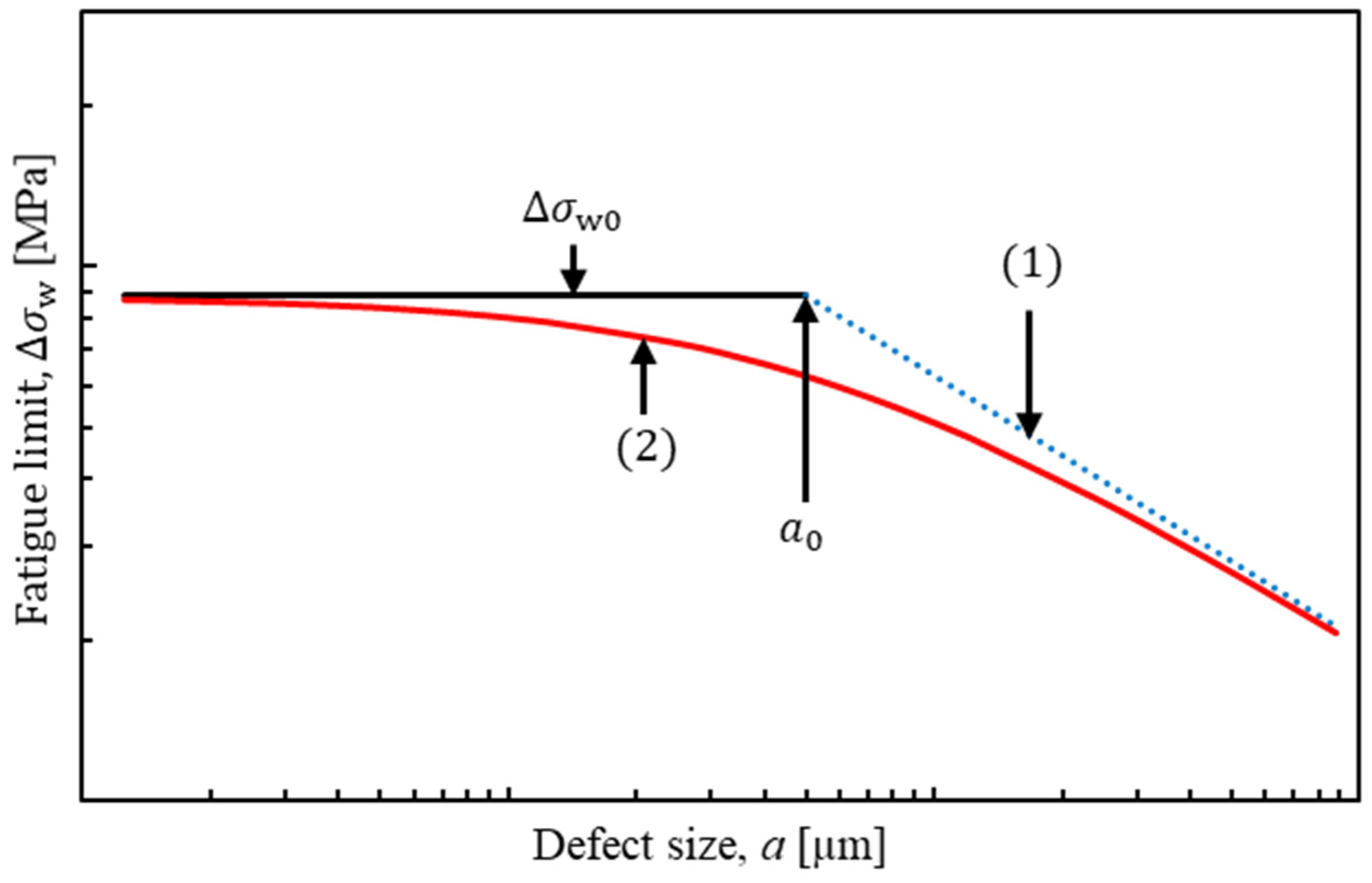
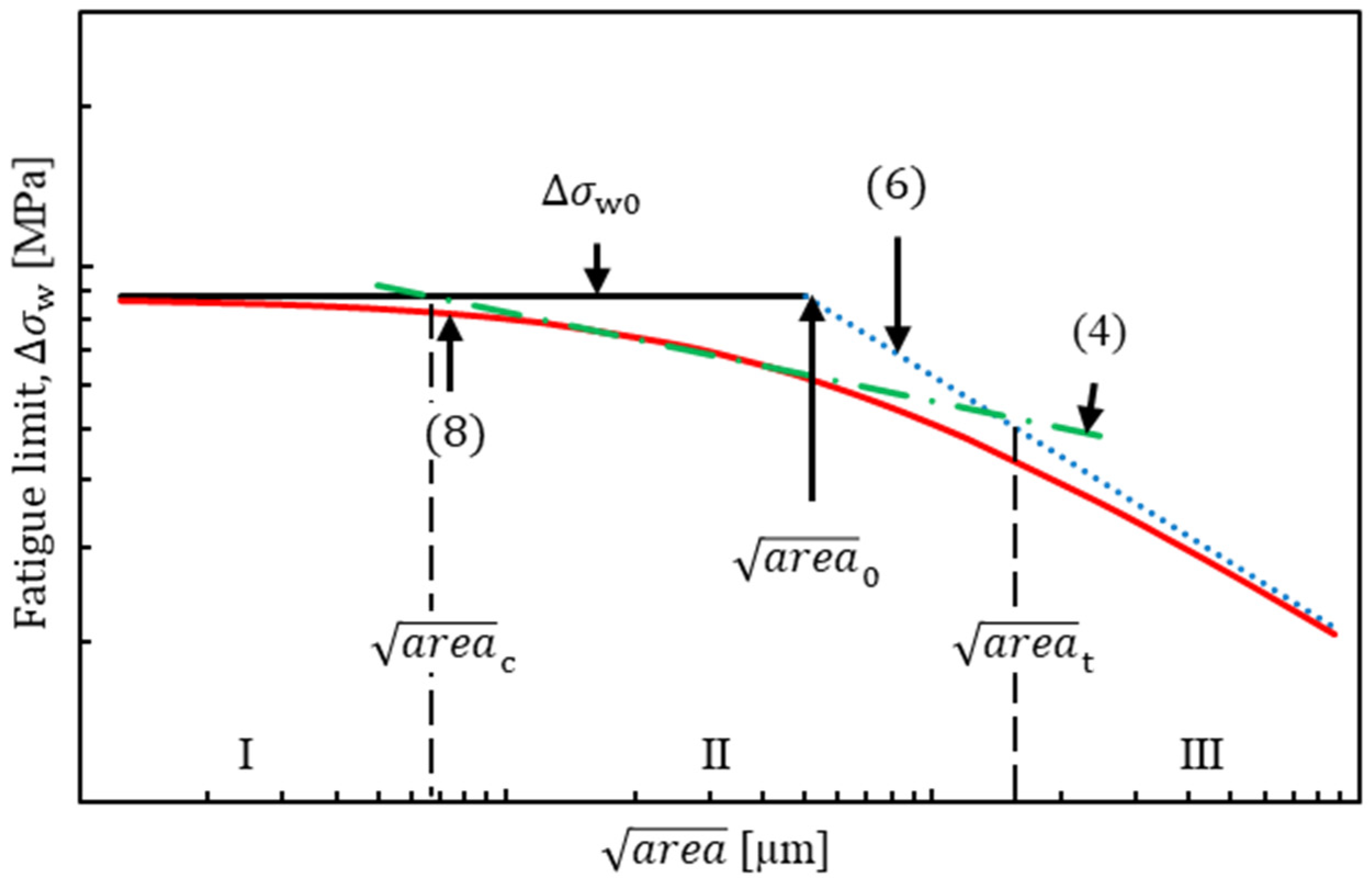

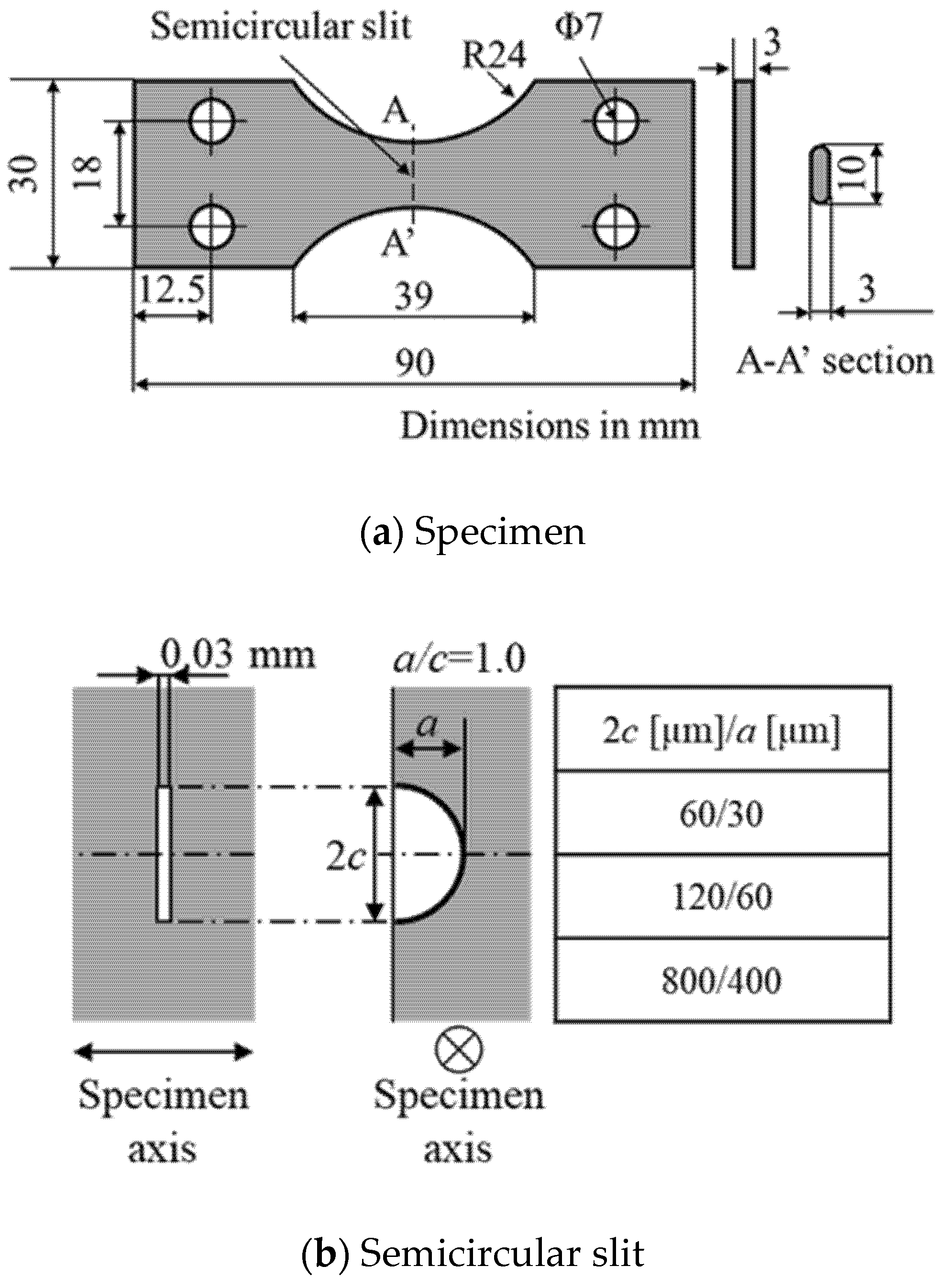
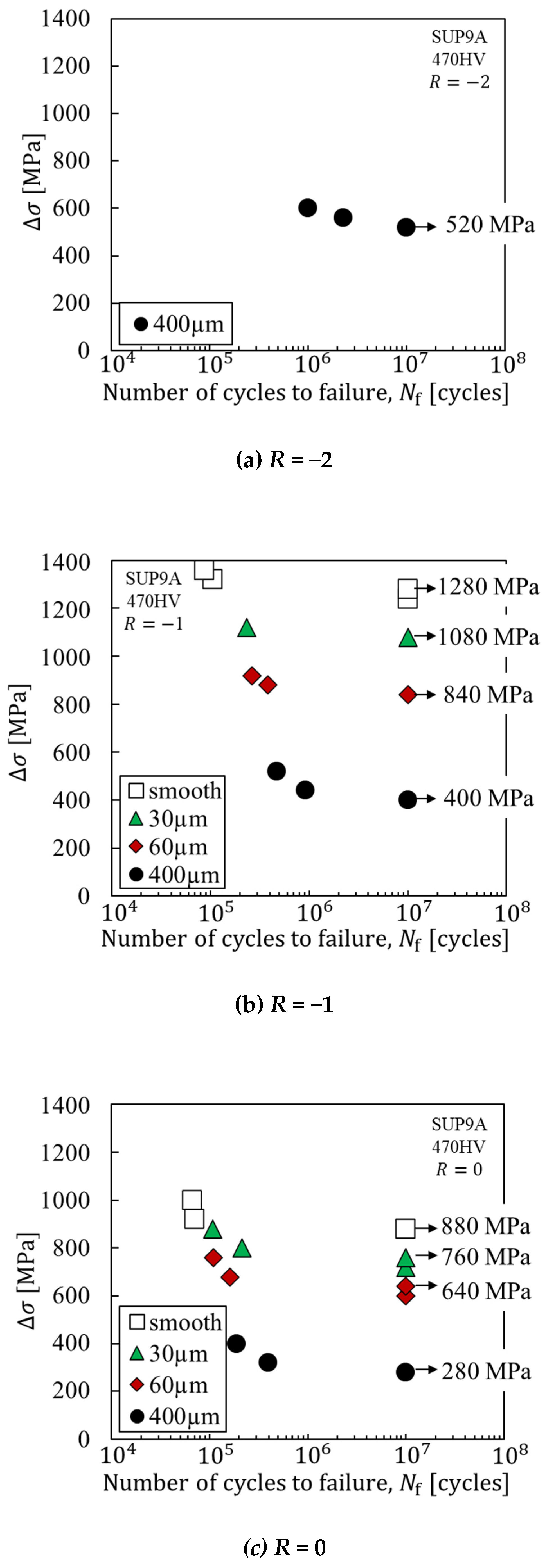

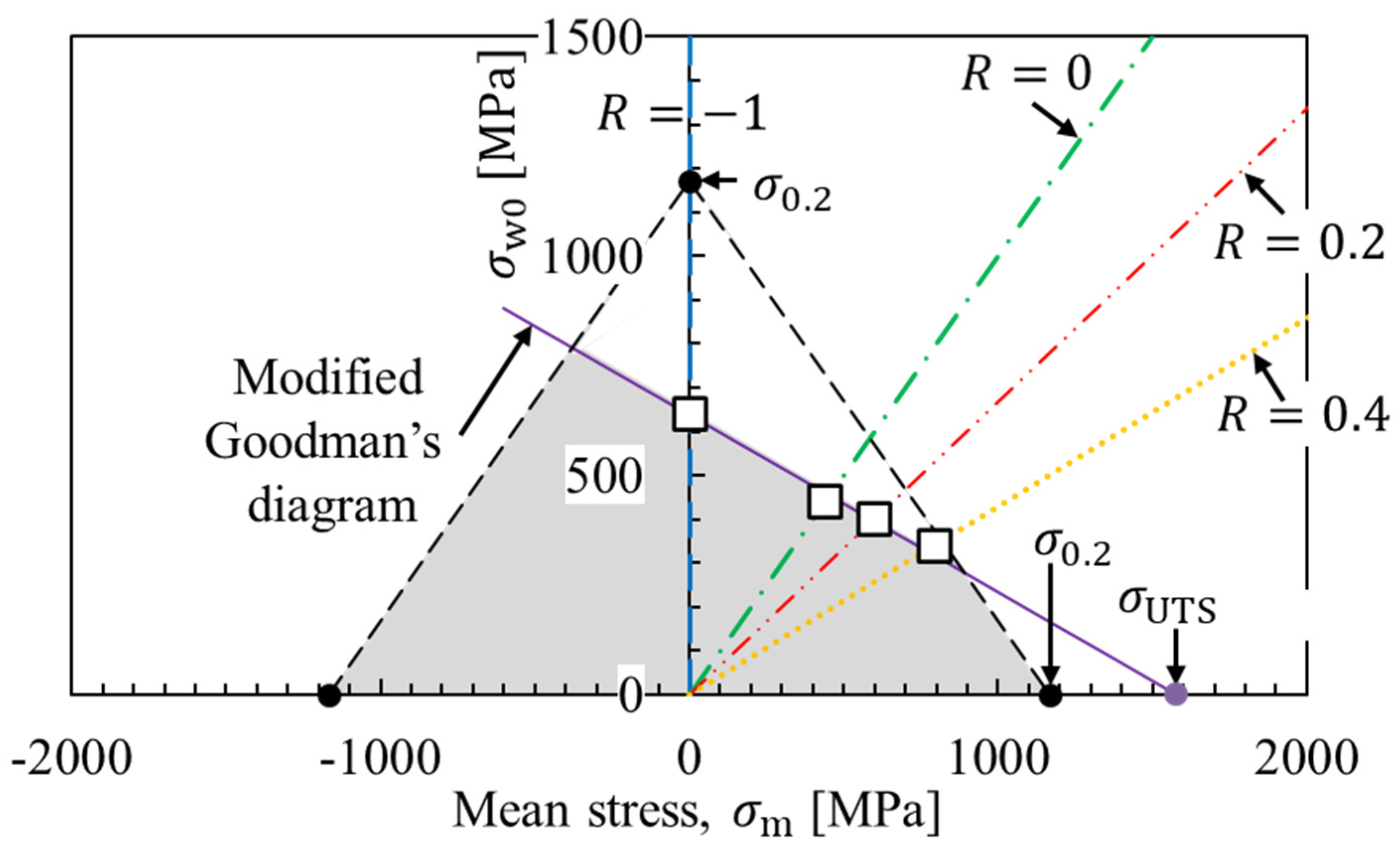

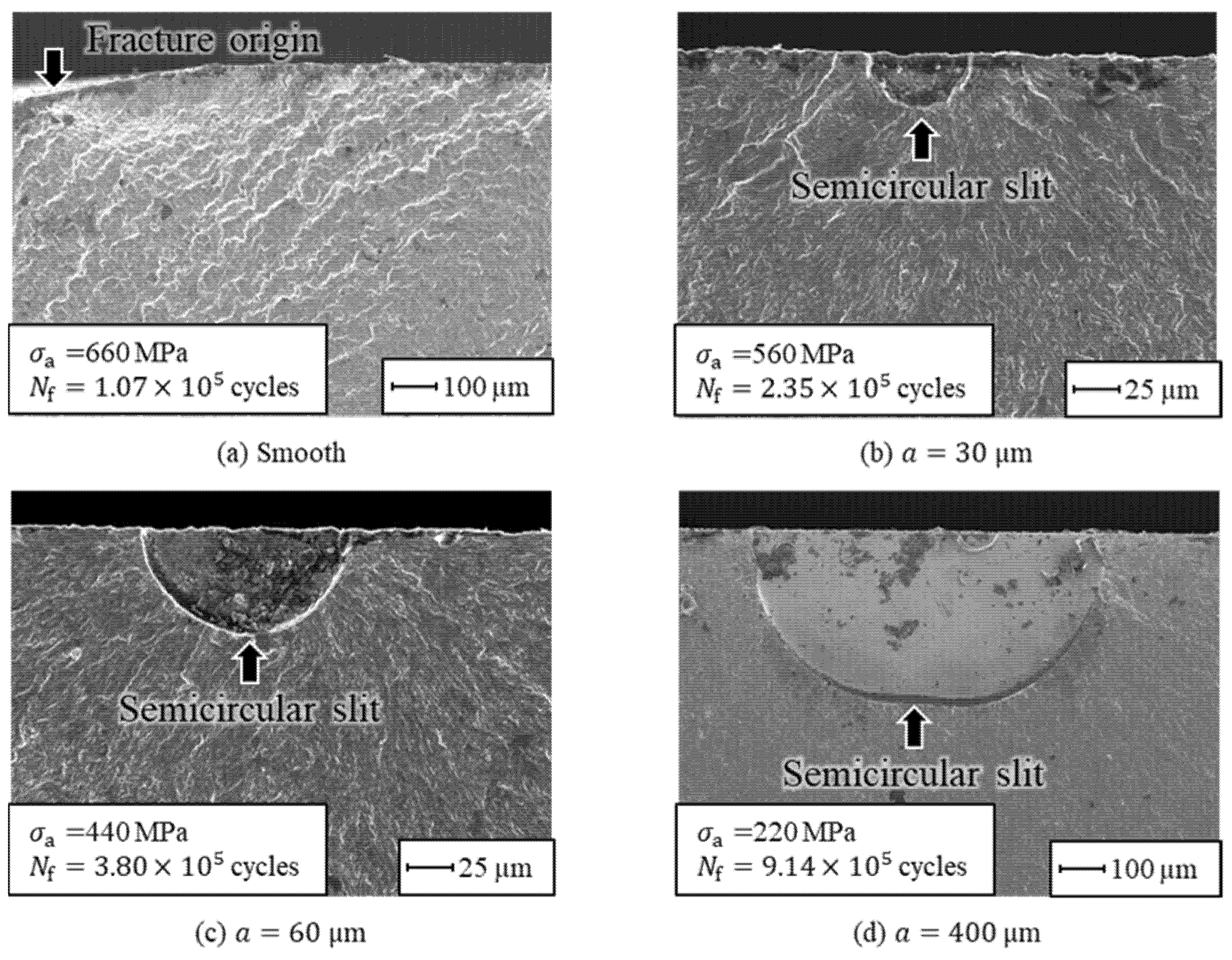
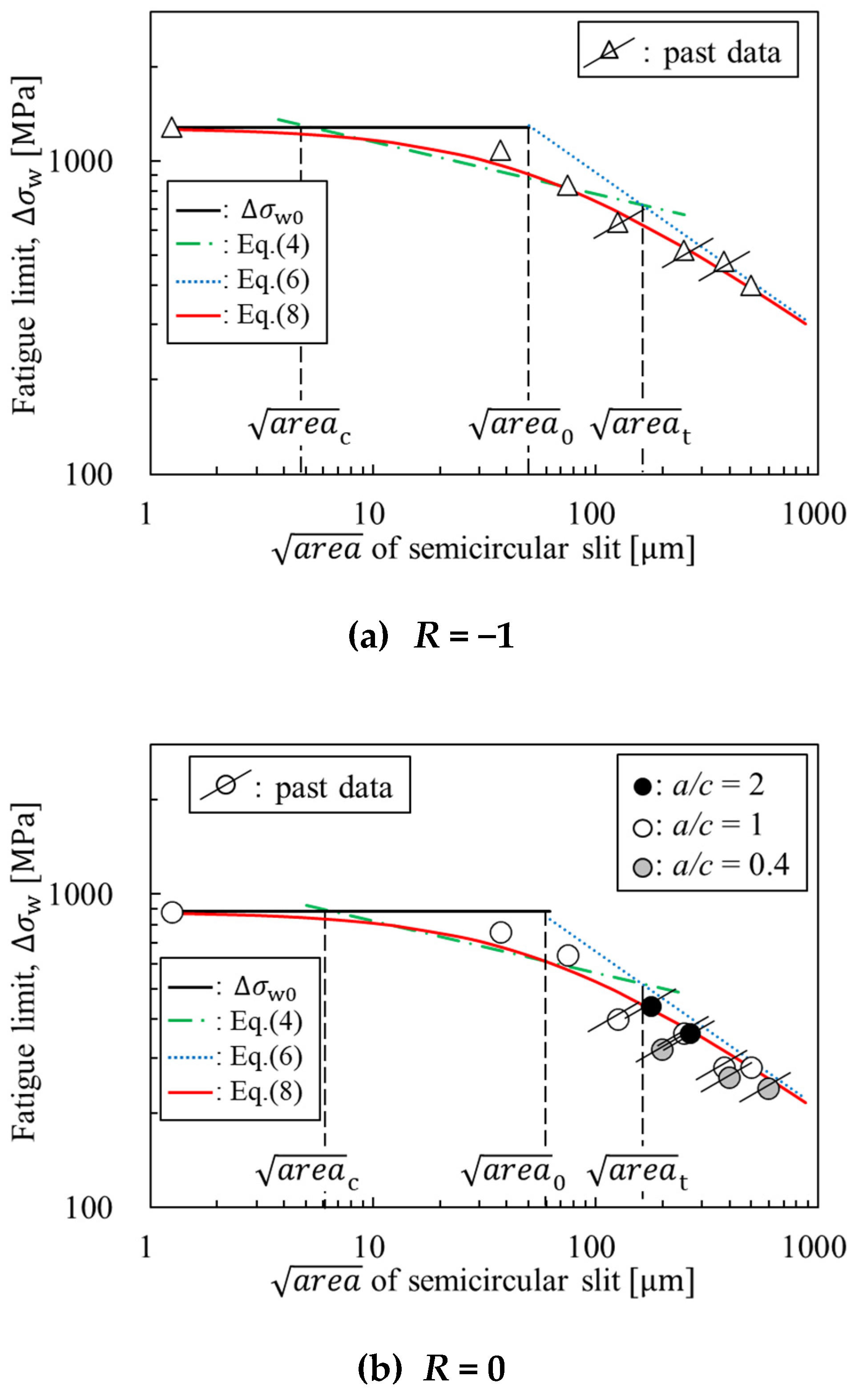

| C | Si | Mn | P | S | Cu | Ni | Cr | Fe |
|---|---|---|---|---|---|---|---|---|
| 0.57 | 0.25 | 0.86 | 0.022 | 0.019 | 0.2 | 0.11 | 0.82 | Bal. |
| −1 | 30 | 1080 | 1280 | 0.84 |
| 60 | 840 | 0.66 | ||
| 400 | 400 | 0.31 | ||
| 0 | 30 | 760 | 880 | 0.86 |
| 60 | 640 | 0.73 | ||
| 400 | 280 | 0.32 | ||
| 0.2 | 30 | 760 | 800 | 0.95 |
| 60 | 600 | 0.75 | ||
| 400 | 260 | 0.33 | ||
| 0.4 | 30 | 680 | 680 | 1.00 |
| 60 | 560 | 0.82 | ||
| 400 | 240 | 0.35 |
| R (−) | ||
|---|---|---|
| −1 | 1280 | 10.61 |
| 0 | 880 | 7.57 |
| 0.2 | 800 | 6.79 |
| 0.4 | 680 | 5.90 |
| R (−) | |||
|---|---|---|---|
| −1 | 5.25 | 51.7 | 163 |
| 0 | 6.55 | 55.7 | 163 |
| 0.2 | 6.05 | 54.2 | 163 |
| 0.4 | 6.91 | 56.7 | 163 |
Publisher’s Note: MDPI stays neutral with regard to jurisdictional claims in published maps and institutional affiliations. |
© 2021 by the authors. Licensee MDPI, Basel, Switzerland. This article is an open access article distributed under the terms and conditions of the Creative Commons Attribution (CC BY) license (http://creativecommons.org/licenses/by/4.0/).
Share and Cite
Ishii, T.; Takahashi, K. Prediction of Fatigue Limit of Spring Steel Considering Surface Defect Size and Stress Ratio. Metals 2021, 11, 483. https://doi.org/10.3390/met11030483
Ishii T, Takahashi K. Prediction of Fatigue Limit of Spring Steel Considering Surface Defect Size and Stress Ratio. Metals. 2021; 11(3):483. https://doi.org/10.3390/met11030483
Chicago/Turabian StyleIshii, Takehiro, and Koji Takahashi. 2021. "Prediction of Fatigue Limit of Spring Steel Considering Surface Defect Size and Stress Ratio" Metals 11, no. 3: 483. https://doi.org/10.3390/met11030483
APA StyleIshii, T., & Takahashi, K. (2021). Prediction of Fatigue Limit of Spring Steel Considering Surface Defect Size and Stress Ratio. Metals, 11(3), 483. https://doi.org/10.3390/met11030483







